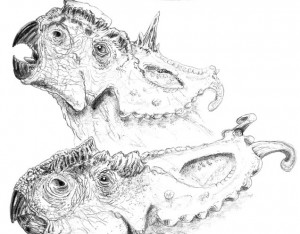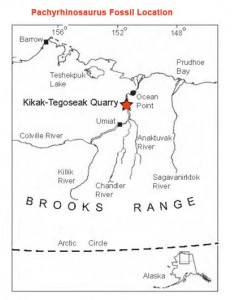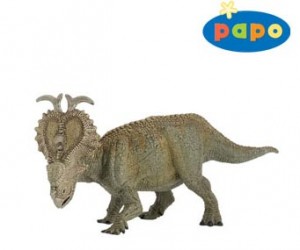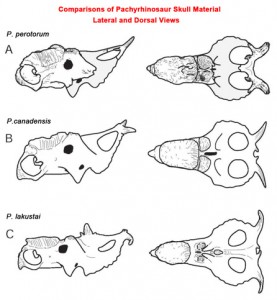A New Species of Pachyrhinosaurus is Announced
A Polar Pachyrhinosaurus – horned dinosaur of the Arctic
Scientists from the Museum of Nature and Science (Dallas, Texas) are going to announce at the annual meeting of the Society of Vertebrate Palaeontology in Las Vegas that they have discovered a new species of horned dinosaur (Pachyrhinosaurus). The fossilised remains of at least ten individuals have been excavated from a dig site well inside the Arctic circle.
Pachyrhinosaurus
The new species will be formally named Pachyrhinosaurus perotorum, in recognition of the Perot family (Margot and H. Ross Perot and their children), who have demonstrated a long history of supporting science and science education for the public and for their financial support of the museum.
In conjunction with the announcement, a draft of the paper that describes the find was posted recently at the website of Acta Palaeontologica Polonica, an international quarterly journal that features papers of general interest from all areas of palaeontology. Jointly submitted by Anthony R. Fiorillo, PhD., the Museum’s chief curator and director of research, and Ronald S. Tykoski, PhD., chief fossil preparator at the Museum, the paper is entitled “A new species of the Centrosaurine Ceratopsid Pachyrhinosaurus from the North Slope (Prince Creek Formation: Maastrichtian) of Alaska.”
The new dinosaur was discovered on lands managed by the Bureau of Land Management, this site has yielded some extraordinary evidence providing scientists with an insight into the lives of polar dinosaurs. The research was funded by the National Science Foundation Office of Polar Programmes. The final paper, once reviewed will be published at the end of this year.
The Upper Cretaceous strata of the Prince Creek Formation contain the highest concentration of polar dinosaur fossils known. This new species of Pachyrhinosaurus has been described based on differences between the skulls of known pachyrhinosaurs – P. canadensis and P. lakustai. This new species, shares characteristics with each of these two types of horned dinosaur, but the differences in anatomy and skull morphology are enough to permit the research team to propose a new species.
An Illustration of a Typical Pachyrhinosaurus
Picture credit: Mike Fredericks
Interestingly, based on an analysis of the rock strata, this new species of ceratopsian is the youngest known Pachyrhinosaurus. The rocks which yielded the fossilised bones have been dated to around 70-69 million years ago (Maastrichtian faunal stage), perhaps this type of horned dinosaur was able to survive as a specialist herbivore living at high latitudes, whereas other types of pachyrhinosaurs were replaced by different types of horned dinosaur such as the larger Triceratops at lower latitudes.
Dr Fiorillo, one of the authors of the scientific paper commented:
“Discovering hundreds of bones from all these pachyrhinosaurs in one spot was unbelievably exciting, and we really thought the expedition was an incredible success. To later realise that we had unearthed a whole new species was one of the best days of my career.”
Dr Fiorillo and his colleagues unearthed the remains of this new species during a return excavation in 2006 in the far north of Alaska, many miles north of the Arctic Circle. The location had been explored on numerous previous expeditions, the team’s time at the site being restricted because of the harsh working conditions, the remote location and the continuous threat of bad weather.
A Map Showing the Fossil Site Location
Picture credit: Perot Museum of Science and Nature
A film crew fortuitously captured the unearthing of the skull and hundreds of surrounding fossils that came from at least ten Pachyrhinosaurus individuals. Alaska has provided scientists with some fascinating evidence indicating that there were resident dinosaurs this far north during the Late Cretaceous. The lush polar conifer forests were also a seasonal home to large numbers of hadrosaurs that migrated north, probably to take advantage of the twenty-four hour days that this region had during the polar summer. It is not known whether these pachyrhinosaurs were seasonal migrants or present in the area all year long. The numerous fossil bones all found in one locality indicate herding behaviour, but it is uncertain whether these large dinosaurs were permanent residents. Recently, isotope evidence taken from the teeth of camarasaurids was claimed to show migration behaviour in Jurassic sauropods.
To read more about this: Camarasaurids – Evidence for Seasonal Migration.
Once that season’s dig was completed, Fiorillo and his team meticulously packaged the precious cargo in plaster-burlap jackets (although getting plaster to harden in sub-zero temperatures proved challenging), then painstakingly airlifted these precious artefacts by helicopter to a nearby airstrip where they were flown back to Fairbanks (Alaska) before continuing their long journey south towards Texas. Perhaps, in a reflection of what took place seventy million years ago, these rhino-sized dinosaurs were once again migrating south.
Upon their arrival in the palaeontology laboratory at the Museum of Nature and Science, the jackets were handed over to Dr Tykoski, who spent the next several years meticulously whittling away the 70 million-year-old sediment that entombed the dinosaur bones.
Dr Tykoski described the preparation process as:
“It’s as if someone took 15 pachyrhinosaurs, dumped them into a blender for 30 seconds, poured all the mess out into a ball of concrete, then let it solidify for seventy million years.”
In early 2011, Dr Tykoski, Dr Fiorillo and their colleagues were stunned and excited when the newly cleaned and reassembled pieces clearly showed they had found a new species of the Pachyrhinosaurus. A reconstruction of the Pachyrhinosaurus (P. perotorum) will form part of the new dinosaur hall that is being constructed at the museum. This id due to open in early 2013.
A Model of a Pachyrhinosaurus
Picture credit: Everything Dinosaur
The picture above shows the Papo “Les Dinosaures” Pachyrhinosaurus model.
To view the Papo Pachyrhinosaurus and the other prehistoric animal figures (whilst stocks last): Papo Models and Figures (Les Dinosaures).
Analysis of the skull material, the size of the fenestrae in the skull and the morphology of the skull bones led to researchers to conclude that their Pachyrhinosaurus fossils did indeed, represent a new species.
Comparative Line Drawings of Reconstructions of the Three Known Pachyrhinosaur Species
Picture credit: PerotMuseum of Science and Nature
The drawings although not to scale show morphological differences between the skulls of these three different types of pachyrhinosaurs. The areas filled in grey on the drawing of P. perotorum indicate hypothetical morphology not preserved in currently known specimens of P. perotorum.
It is very difficult to assign fossil material of a ceratopsian to a new species. The arduous task of comparing the size and shape of the fossil bones between specimens is complicated by the fact that the size and shape of the neck frill and other parts of the skull changed considerably as the animals got older. The first species of pachyrhinosaur was formally named and described by C. M. Sternberg in 1950, from a series of fossil specimens found in North America. The second species to be named P. lakustai was only formally described just a couple of years ago. P. lakustai was named after the school teacher who first found the bones of this new dinosaur species, to read more about this discovery: New Pachyrhinosaurus Species Honours Discoverer.





